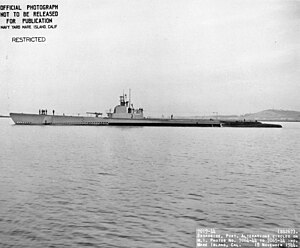USS Pompon

| |
| History | |
|---|---|
| Builder | Manitowoc Shipbuilding Company, Manitowoc, Wisconsin[1] |
| Laid down | 26 November 1941[1] |
| Launched | 15 August 1942[1] |
| Commissioned | 17 March 1943[1] |
| Decommissioned | 11 May 1946[1] |
| Recommissioned | 15 June 1953[1] |
| Decommissioned | 1 April 1960[1] |
| Stricken | 1 April 1960[1] |
| Fate | Sold for scrap, 22 December 1960[1] |
| General characteristics | |
| Class and type | |
| Displacement | |
| Length | 311 ft 9 in (95.02 m)[3] |
| Beam | 27 ft 3 in (8.31 m)[3] |
| Draft | 17 ft 0 in (5.18 m) maximum[3] |
| Propulsion |
|
| Speed | |
| Range | 11,000 nautical miles (20,000 km) surfaced at 10 knots (19 km/h)[2] |
| Endurance |
|
| Test depth | 300 ft (90 m)[2] |
| Complement | 6 officers, 54 enlisted[2] |
| Armament |
|
USS Pompon (SS/SSR-267), a
Construction and commissioning
Pompon was
Service history
On 5 April 1943 Pompon began her voyage down the
First war patrol, July – August 1943
Pompon steamed from
Second war patrol, September – November 1943
Pompon departed Brisbane on 12 September 1943 for her second war patrol, en route to a patrol area in the South China Sea north of Singapore. On 16 September, she sighted an Allied Liberty ship in the Coral Sea 25 nautical miles (46 km; 29 mi) east of Grafton Passage in the Great Barrier Reef at 16°35′S 146°45′E / 16.583°S 146.750°E at 04:05. The ship altered course directly toward her and she submerged. After Pompon returned to the surface, she unsuccessfully attempted to exchange recognition signals with the ship, which opened gunfire on her at a range of 12,000 yards (11,000 m) at 06:14. Pompon submerged again and suffered no damage.[7]
After reaching her patrol area, Pompon made several unsuccessful attacks and experienced a near miss by a Japanese submarine. She returned to Fremantle, Australia on 5 November 1943 for supplies.
Third and fourth war patrols, November 1943 – April 1944
The third patrol began on 29 November and again took her to the China Sea area off French
On 22 February, Pompon departed on her fourth patrol, and operated in the vicinity of Halmahera Island. She launched four torpedoes at three small Japanese escort vessels, but they ran under their targets due to the escorts' shallow draft. A contact was made in Roeang Passage, but upon closing, it proved to be a hospital ship. She made no further contacts and proceeded to Pearl Harbor via Ascension and Midway, arriving 10 April.
Fifth war patrol, May – June 1944
After a refit and four days training, Pompon was again ready for sea. She departed Pearl Harbor on 6 May 1944 for a patrol off the coasts of
Sixth war patrol, July – September 1944
On 19 July Pompon departed on her sixth and most successful patrol. Operating from the eastern coast of Honshū to the
Seventh war patrol, December 1944 – February 1945
By 13 December the veteran submarine was again at sea. En route to
The next morning, while making a morning trim dive, the conning tower hatch failed. Before the dive could be halted the ship had reached a depth of 44 feet (13 m), partially flooding the conning tower and control room, and completely flooding the pump room. Pompon crept homeward, having to run awash until the blower could be partially restored. While struggling along in this condition, she blundered into an enemy convoy and was sighted. The escorts forced her to dive despite her dangerous condition, but she miraculously escaped. Pogy found her one day out of Midway and led her in on 11 February.
Eighth and ninth war patrols, March – July 1945
Repairs completed, Pompon departed Midway 30 March for her eighth patrol area along the coasts of China and Formosa. Her only contacts, a motor sampan, a hospital ship, and 106 planes, provided excellent diving experience, but poor hunting. Ten survivors from a downed PBM were taken from Ray for transportation to Guam, where Pompon arrived 24 May.
During her ninth, and last, war patrol from 18 June to 22 July, she operated as a lifeguard in the Truk area. There were no ship contacts and few plane contacts. She was at Guam when the news of the war's end came. On 22 August she began her homeward voyage, arriving at New Orleans on 19 September.
Post-war service as radar picket
On 11 May 1946 Pompon was decommissioned and placed in the U.S. Atlantic Reserve Fleet, New London. On 15 June 1953 she recommissioned as SSR-267, after being converted to the latest type radar picket submarine.
After a shakedown cruise to
During September and October 1957 Pompon participated in the large scale
Decommissioning and disposal
Following decommissioning Pompon was struck from the Navy List 1 April 1960, and was sold to Commercial Metals Company for scrap on 25 November 1960.
Honors and awards
Pompon earned four
Commemoration
One of Pompon′s propellers can be seen today on the river walk in Old Town Alexandria, Virginia. It is one block north of the Torpedo Factory Art Center on a concrete slab in the water of the Potomac River.
References
Citations
This article incorporates text from the public domain Dictionary of American Naval Fighting Ships. The entry can be found here.
Bibliography
- Hinman, Charles R., and Douglas E. Campbell. The Submarine Has No Friends: Friendly Fire Incidents Involving U.S. Submarines During World War II. Syneca Research Group, Inc., 2019. ISBN 978-0-359-76906-3.
